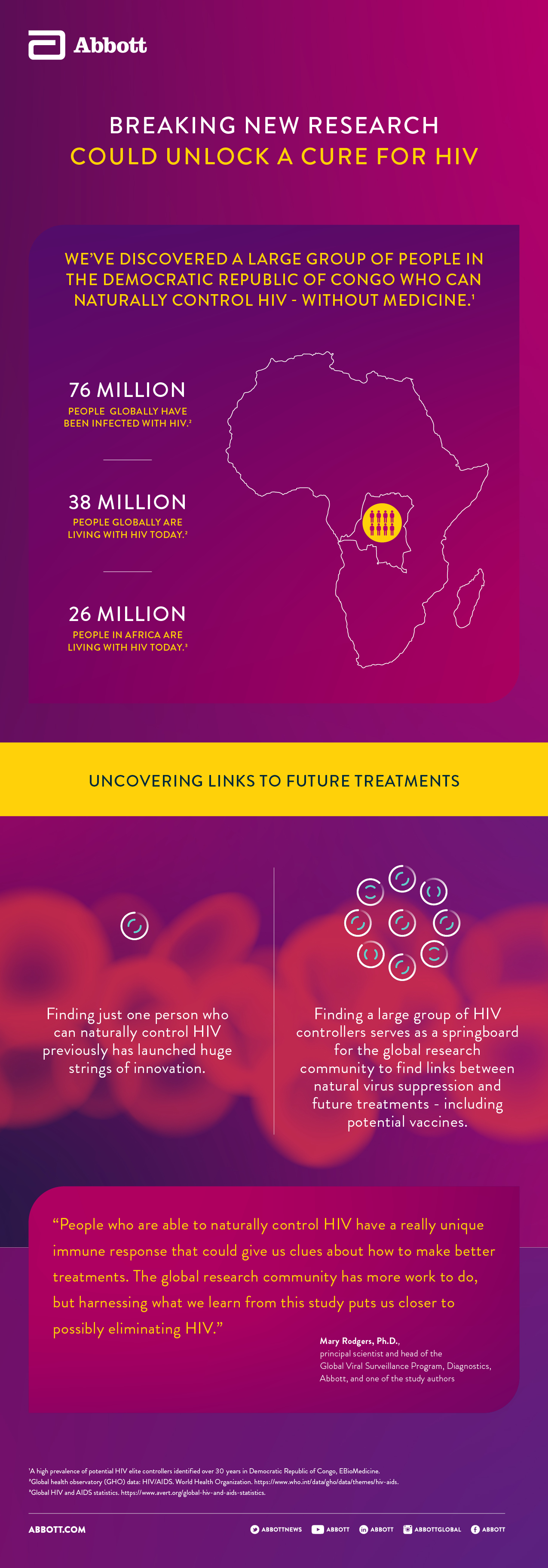
HIV Controllers: A New Phenomenon in HIV Research
Abbott Virus Hunters Take Another Stand Against HIV.
Mar. 02, 2021
- Copy Link
- Share on X
- Share on Facebook
- Share on Linkedin
Abbott Virus Hunters have dedicated more than 26 years to staying ahead of viral threats such as HIV. Their continuous work led to the identification of a new strain of HIV in 2019.
Now, we've found a unique group of people that may advance our understanding of HIV and pave the way toward a potential cure.
Our Virus Hunters, alongside researchers from the Johns Hopkins University, the University of Missouri-Kansas City (UMKC), National Institute of Allergy and Infectious Diseases (NIAID) and the Université Protestante au Congo (UPC), have identified a group of rare HIV carriers in the Democratic Republic of Congo (DRC) who test positive for HIV antibodies, but have low to non-detectable viral load counts — without the use of antiretroviral treatment (ART).1
What this means is this group, known as HIV elite controllers, displays no symptoms. The disease doesn't progress or it progresses much slower for them.
Before the findings of this research in EBioMedicine, only a few cases of HIV elite controllers were identified. By identifying a larger group in the DRC, researchers can look to understand more biological trends and hopefully uncover information that could lead to advancements in treatments and potentially vaccines.
The Search for a Phenomenon
Today, roughly 38 million people are known to be living with HIV. Though HIV is a chronic, lifelong condition, medical and technological advancements have allowed those living with HIV to maintain a healthy life while receiving treatments and therapies.
As the first to develop an approved FDA test for HIV more than 30 years ago, we understand the importance of HIV research. And with the origins of the HIV epidemic traced to sub-Saharan Africa, specifically the Democratic Republic of Congo (DRC), this region is of specific interest to the scientific community.
In urging the people of the DRC to get tested for HIV and know their status, the team noticed something significant: While antibody positive cases were being picked up on our ARCHITECT® system, viral loads for those same people were not detected in PCR (polymerase chain reaction) tests on our m2000™ RealTime system.
This means an individual was infected at some point (presence of HIV antibodies), but had no evidence of an active infection (lack of a viral load). Considering that HIV is a condition that typically progresses over time, finding a large group of HIV elite controllers in the DRC is significant. Further studies are needed to understand the relationship between natural HIV suppression and a potential cure for the disease and this current study serves as a springboard.
"Global surveillance work is critical to staying ahead of emerging infectious diseases and in this instance we realized we found another piece of the HIV puzzle," said Michael Berg, Ph.D., an associate research fellow in infectious disease research at Abbott, and lead author of the study. "The global research community has more work to do, but we're a step closer to finding links between natural virus suppression and future treatments."
A Quarter Century of Virus Hunting
More than 60 percent of the world's blood supply is screened through our instruments. As a leader in blood screening and infectious disease testing, we created our Global Viral Surveillance Program more than 25 years ago to monitor HIV and hepatitis viruses and identify mutations, which helps ensure the company’s diagnostic tests remain up to date. The program continues to be a pathway fueled by collaboration, enabling researchers to proactively evaluate and solve infectious disease challenges.

References
1 A high prevalence of potential HIV elite controllers identified over 30 years in Democratic Republic of Congo, EBioMedicine
For the latest on Abbott’s life-changing technology, get updates directly in your inbox.